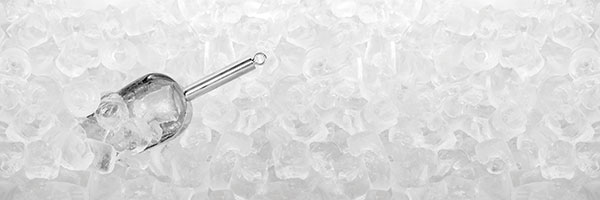
Slime in the Machine
October 4, 2023 | By Dave Demma
For refrigeration professionals who service the food service industry, Dave Demma provides a step-by-step procedure for ice machine cleaning.

(Adobe Stock)
For everyone who experienced the high humidity pleasure of living in the Houston, Texas area in the 1980’s, they would all be familiar with television personality Marvin Zindler’s “Rat and Roach” report. Zindler would chronicle some of the local restaurants that had been flagged by the health department for various infractions, including rats and roaches, meat stored at improper temperatures, and what became the tag line he was most known for … “slime in the ice machine”.
While this proved to be a very entertaining segment on the local news, it also brought to light one of the major issues with ice machines.
There are many who think that once an ice machine is set up, and properly making ice, it needs no further attention. As with any expensive piece of machinery, this approach can certainly lead to problems, and expense.
In Canada and the U.S., ice intended for human consumption is regulated as a food. As such, the quality of the ice is under scrutiny. Freezing water does not kill bacteria nor inactivate viruses.
Without sufficient maintenance and cleaning, bacteria and mold can build up in an ice machine, contaminating the ice. This can lead to a poor health inspection score and possibly result in sick customers.
Depending on the ice machine manufacturer, recommendations for cleaning may vary from monthly to bi-yearly.
For refrigeration professionals who service the food service industry, below is a typical step-by-step procedure for ice machine cleaning:
- Remove Scale
- Remove machine front panel
- Turn machine off
- Remove ice from storage bin
- Remove machine inner panel
- Remove water reservoir cover
- Shut off water supply valve
- Locate evaporator drain, unplug it, and drain evaporator
- Re-plug evaporator drain
- Mix a solution of ice machine cleaner and water
- Fill water reservoir with solution
- Put machine into clean mode and start
- Continue adding fluid to the water reservoir as ice is being made
- Turn machine off after clean mode is complete
- Remove drain plug from reservoir, drain solution, replace plug
- Melt any accumulated ice in ice bin
- Use a mixture of scale remover and water to wash reservoir cover, ice chutes, storage bin and covers.
Sanitize
- Mix a solution sanitizer and water.
- Pour solution into the reservoir, and let sit for 2 minutes.
- Open water supply valve.
- Start ice machine.
- Operate machine for at least 15 mins.
- Stop machine.
- Drain reservoir.
Photo Eye
- Mix a solution of scale remover and water.
- Remove sensors from inner cover.
- Using a cotton swab, use solution to clean sensors.
- Rinse sensors with clean water.
- Reinstall sensors.
Ice Bin
- Use scale/water solution to thoroughly clean bin surfaces.
- Rinse with clean water.
- Use sanitizer/water solution on all surfaces that will be in contact with ice.
- Rinse with clean water.
The machine is now clean, and ready to produce contaminant and bacteria-free ice for consumers.
On the refrigeration side, it is important to ensure that the condenser is clean. This will allow the condensing unit to operate at its most efficient level. A dirty condenser in the middle of the summer could greatly reduce the lbs/day production of the machine.
If the machine utilizes an indoor condenser, and employs an air filter, this can be removed and cleaned.
The condenser coil should also be inspected/cleaned. If the machine utilizes a remote condenser, this should also be inspected/cleaned.
And then, there’s the water.
A good water distiller will remove 99.9% of dissolved inorganics, bacteria, and chemicals from water.
So, in a perfect world, the ice machine would use 100% distilled water, producing the purest prettiest ice imaginable.
Of course, this isn’t practical. But, good water filtration can produce amazing ice.
Sediments and other particulate matter is present in drinking water. In addition, chlorine is also present. While chlorine is important in delivering bacteria-free water, it does not make for good tasting ice. A good carbon filter will remove sediments and other particulate matter along with chlorine.
Commercial ice machines are continually circulating water over the cold evaporator surface, freezing the purest water, and leaving the scaled water in circulation.
Ultimately, this water is flushed, but it is in circulation for a time…allowing the scale the opportunity to deposit on the surfaces it comes into contact with.
Slow-release polyphosphates, as an added filter component, will act as a de-scaler. This will prevent dissolved minerals in the circulating water from solidifying in the icemaker during the freezing process.
The polyphosphates dissolve very slowly, changing how certain minerals react in water. This will allow the mineral content to remain solvent, rather than become a deposit in the machine. This “in solution” content is then flushed at the end of the ice making cycle, along with the remaining water from that cycle.
There’s an old saying when communicating with equipment owners about the benefits of maintenance; you can either pay me a little now, or a lot later during an emergency breakdown.
There’s no question that a good water filter regimen has a cost attached to it. But the preventative nature of using filters, along with periodic cleaning, will not only produce better looking and tasting ice, but it will reduce breakdowns, ice shortages, and increase equipment life.
And, it will eliminate slime in the ice machine. <>

 Dave Demma holds a degree in refrigeration engineering and worked as a journeyman refrigeration technician before moving into the manufacturing sector where he regularly trains contractor and engineering groups. He can be reached at ddemma@uri.com.
Dave Demma holds a degree in refrigeration engineering and worked as a journeyman refrigeration technician before moving into the manufacturing sector where he regularly trains contractor and engineering groups. He can be reached at ddemma@uri.com.


